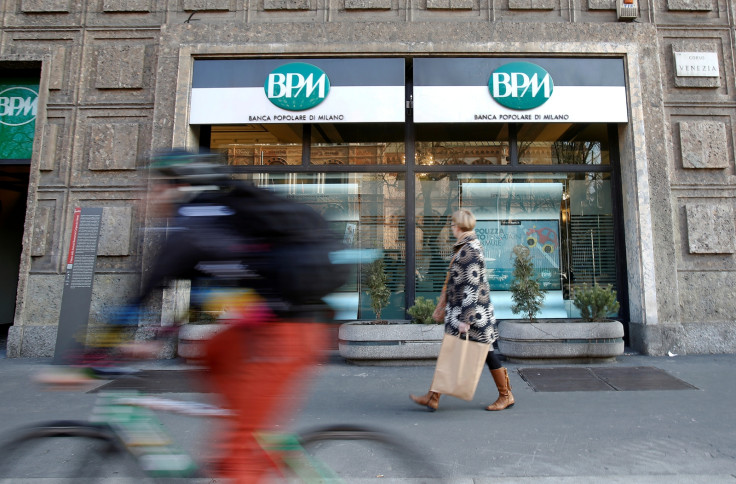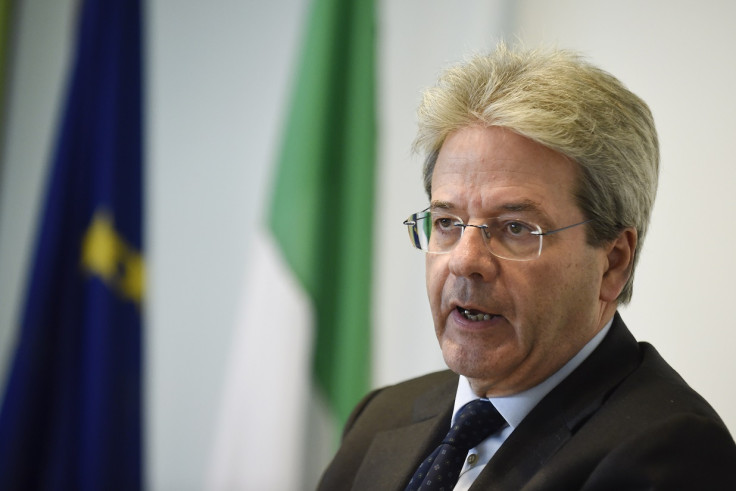Too big to save? How Italy's banking system could lead to the unravelling of the European Union
Eurozone's third biggest economy faces a financial ultimatum.

With its wine, food, architecture and fashion, Italy is seen by many as the land of La Dolce Vita.
But it is also the eurozone's third-biggest economy. It holds the second-largest government debt-to-gross domestic product ratio in the EU. It is the world's number three sovereign debt (bond) market after US and Japan. And it is a G7 country.
So the peninsula is no small fry for potential reverberations to the global financial system.
Italy is in a banking crisis. The struggling Banca Monte dei Paschi di Siena (MPS) – the world's oldest operating bank – needs to raise €5bn (£4.2bn, $5.2bn) in new capital by the end of December. If it does not, the Italian banking system could lead to the unravelling of the eurozone.
Italy's public debt ratio stands at 133% of GDP and they haven't managed to trim it since 2007, despite government announcements about tackling it. The latest Bank of Italy data reports the country's public debt rose slightly to €2.22trn in October. With this huge debt hanging over Italy, the country is facing a ticking time bomb with its simmering banking crisis.
Italy's government has asked parliament to approve €20bn in higher debt for the country's banking sector, to provide liquidity to the nation's troubled banks.
MPS, established in 1472 – two decades before Christopher Columbus bumped into the Americas – may spoil Christmas for quite a few families, as well as for bankers and officials. The traditional Panettone could come with a bitter taste for retail depositors, bondholders and shareholders of the Tuscan-based lender. It may well dampen the festive spirit for many other Italians.
MPS, Italy's number three lender by assets, needs to raise fresh capital after it flunked European stress tests this summer. In recent days the European Central Bank signalled that it won't give the Italian lender an extension. The bank, headquartered in the picturesque city of Sienna, has received billions of euros of bailout funds in the last decade.
MPS is one of the most vulnerable lenders amid Italy's troubled banking sector. Its shredded balance sheet reflects both the legacy of its costly acquisition of an Italian rival and a large portfolio of non-performing loans.
Italy's economy has hardly grown since the country adopted the euro in 1999, while managing to exit its longest postwar recession only last year. Companies going bust and households not returning to pre-crisis spending habits have all contributed to a massive hit in the banks' balance sheets.
Italian banks' doubtful and non-performing loans amounted to more than €350bn in the second quarter of the year, easily dwarfing the amount elsewhere in the EU. The next one down the list – France – came in at almost €200bn less, according to Bloomberg calculations. This debt amounts to almost a fifth of the banks' loans portfolio. It's the equivalent of around 20% of Italy's GDP.
In the past Italian households would hold their local bank manager in high esteem, similar to the consideration given to the parish priest or family doctor. Household savings represented a significant part of bank funding as families bought financial instruments sold by their lender. Italian governments, when taking action in the sector, are well aware of the close ties between the two.
If MPS isn't dealt in a swift and credible way the Italian banking system could face a blow.
A year ago there was a public uproar after a pensioner hanged himself in his home near Rome. He left a note to his wife saying he blamed his bank for losing the family savings of more than €100,000 after making investments he was assured were safe.
A few days earlier his bank was one of four local ones the government rescued under a package that saved depositors, but hit some 130,000 junior bondholders and shareholders that were sold the financial instruments by the lender — the man that committed suicide was one of them. The government rushed through financial support although, this still hasn't been paid out.
This summer former Prime Minister Matteo Renzi's gambit was to avoid citizens taking a loss and tapping the private sector to save MPS. However, support from professional investors has been tame as the bank was forced to reopen a conversion of some of its debt-to-equity program for 40,000 retail holders of subordinated bonds.

New premier Paolo Gentiloni immediately assured the public that MPS would not be allowed to fail. His options, however, consist of bailing in the bank's junior creditors before the Italian Treasury can make up any further funding cap, or asking for the European Stability Mechanism for a bridge loan.
Political observers note that the first option will likely dent the electoral appeal of Gentiloni's Democratic Party, whereas the second could require complying with tough fiscal conditions. Both outcomes would likely boost the anti-establishment Five-Star Movement's eventual prospects in general elections that must be held by spring 2018.
The insurgent party, often lumped together with Spain's Podemos, France's National Front and Brexit voters as "populists", has insisted the euro itself be subject to a referendum.
What worries the Italian government and its EU peers, as well as central bankers and professional investors, is the risk of contagion from MPS to other local lenders, and eventually to other eurozone countries.
If MPS isn't dealt in a swift and credible way the Italian banking system could face a blow as contagion hits other local lenders, potentially resulting in a run on banks as depositors rush to branches to pull out savings. UBI Banca might walk away from buying three banks under special administration, while Banca Carige, Banca Popolare di Vicenza and Veneto Banca may not be able to raise the €3bn needed in new capital.
The size of Italy's economy and its large banking system make the country just too big for its EU partners to save.
With former Prime Minister Silvio Berlusconi – who would grab the world's attention with embarrassing statements and media details of his Bunga Bunga parties – off the scene and flamboyant Matteo Renzi not premier any more after voters rejected a December referendum on government constitutional changes, the major problem has to be faced by Gentiloni.
A positive sign came in recent days from the financial market reaction to the announcement of UniCredit, Italy's biggest lender, selling shares worth €13bn and dispose of some of its bad loans to strengthen its balance sheet. Investors liked the bold measures as an indication UniCredit is serious about its turnaround.
On the other hand, it's looking ever more likely Italian public money will be needed in some form for MPS. The question will be what conditions it will have to face from the EU to comply with state aid limits, and how Italians will behave.
The reaction may decide whether the Italian banking situation retreats to being a local issue or to bring the eurozone breakup issue back to the fore – after lying low for the past couple of years.
The size of Italy's economy and its large banking system make the country just too big for its EU partners to save.
Liam Moloney is a journalist based in Rome. He has covered Italy since 1997 for publications including Bloomberg, Dow Jones and the Wall Street Journal.
© Copyright IBTimes 2025. All rights reserved.





















